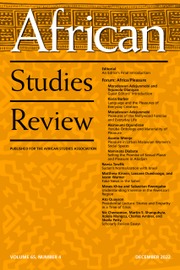Climate Change Epistemologies in Southern Africa: Social and Cultural Dimensions is divided into three parts and contains a total of eight chapters. It is edited by Jörn Ahrens and Ernst Halbmayer who are also the authors of the Introduction, which must be pinpointed as a text of major interest and relevance to the subject matter of the book.
In their introduction they analyze several issues necessary for a comprehensive reading of climate change. They do that with a particular focus on the need to consider the diversity of consequences and challenges that these changes may entail for the African region. Ahrens and Halbmayer stress the importance of the inclusion of Africa and the socio-cultural heritage of its people in the overall problematics.
This is certainly why the authors have organized the book into three parts. The first is entitled “Climate and climate change epistemologies” and is made up of four chapters. The second part, made up of two chapters, is entitled “Climate change communication” and the third, “Just transition and international cooperation,” also contains two chapters.
In the first part, the chapters by Michael Bollig, Michael Sheridan, Werner Nell, and Patrick Bond and Mary Galvin propose an epistemological approach to climate change, by integrating knowledge and social representations, taking people from Namibia and South Africa as references. Several aspects of great relevance are worth mentioning: i) the analyses of the necessarily different local perceptions of adaptive resilience; ii) the logics of understanding of pastoral peoples such as the Himba and the Herero of Namibia, brought up here by Bollig; iii) or the socio-historically and culturally based assumptions about rainmaking rituals, or about queen rains, male rains, and female rains and other values of great complexity for foreign understanding, treated in a very valuable way by Sheridan. In this part of the book, we also find the text by Bond and Galvin where the authors make a reading of the conflictual opposition deriving from local narratives about climate disasters and the opportunistic narratives of political discourses.
The relevance of these texts is twofold, as they both legitimize the knowledge of local populations regarding their perceptions of climate change and their representations of the diversity of phenomena and offer useful perspectives for understanding sustainable and pragmatic local adaptation strategies.
The two chapters in the second part of the book deal with the importance of communication on climate issues. The text by Scott and Taylor entitled “Receptivity to the knowledge of others: Building urban climate resilience in Southern African cities” discusses the importance of collaborative processes and transdisciplinary approaches in work on climate change and sustainability. It is based on a debate about the concept of receptivity and the importance of recognizing the possibilities of its effects on project planning, particularly projects on climate change and the processes of adaptation to the climate transition of populations in Africa. The discussion on the advantages of incorporating and configuring the concept of receptivity as an advantageous methodology for planning actions for change, useful for sustainability, should be emphasized. It is a text that reveals an understanding of the importance of constructing socio-culturally comprehensive work.
Chapter Six, by Faimau, Sello, and Nkhukhu-Orlando, deals with print media coverage and the socio-contextual representations of climate change in Botswana and shows how the media has difficulties in disseminating information about transformative discourses on climate and sustainability practices. This, in addition to the predominance of references to non-African contexts in government discourses, means that little attention is paid in the press to problematizing the involvement of citizens.
Issues of cooperation in the field of climate change are dealt with in the third part of this book. Chapter Seven by Vanderheiden deals with “Climate change equity and extreme vulnerability,” and Rompel’s text addresses the issue of “Adaptation to climate change in Southern Africa: Challenges for sustainable development and the role of international cooperation.”
The texts emphasize the idea that the lines of international cooperation on climate, particularly North-South cooperation, are governed by a complex political framework, which implies the need to consider a set of constraints that involve the negotiation of often unnoticeable interests. Vanderheiden calls for attention to these challenges, highlighting issues such as ethics in cooperation, the priorities of different sovereignties, the challenges of managing national, regional, and international interests, among other forces. The various constraints on the implementation of action strategies and policies can, according to the author, hinder the progress of significant actions and jeopardize the future of sustained cooperation on climate transition, which in the region is already precarious and uncertain. He also emphasizes the importance of adapting to climate change as a fundamental strategy, which cannot fail to be based on recognizing the importance of the social and cultural dimensions of the various peoples in their regions.
In fact, Climate Change Epistemologies in Southern Africa recognizes the limitations of conventional science in addressing environmental issues, the multifaceted nature of the environment, and the multifaceted impacts of climate change and its variability in the African region. Local knowledge results from the experience and interaction of communities with the history of their territory and this must be taken into account when trying to understand the scope of the intelligence of communities in their relationship with the environment and with climate change.


